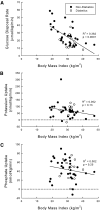Comparison of insulin action on glucose versus potassium uptake in humans
- PMID: 21734082
- PMCID: PMC3133473
- DOI: 10.2215/CJN.00750111
Comparison of insulin action on glucose versus potassium uptake in humans
Abstract
Background and objectives: Insulin has several physiologic actions that include stimulation of cellular glucose and potassium uptake. The ability of insulin to induce glucose uptake by cells is impaired in type 2 diabetes mellitus, but whether potassium uptake is similarly impaired is not known. This study examines whether the cellular uptake of these molecules is regulated in concert or independently.
Design, setting, participants, & measurements: Thirty-two nondiabetic and 13 type 2 diabetic subjects with normal GFR were given a similar, constant metabolic diet for 8 days. On day 9, they were subjected to a hyperinsulinemic euglycemic clamp for 2 hours. Serum and urinary chemistry were obtained before and during the clamp. Glucose disposal rate was calculated from glucose infusion rate during hyperinsulinemic euglycemia. Intracellular potassium and phosphate uptake were calculated by the reduction of extracellular potassium or phosphate content corrected for urinary excretion.
Results: Although glucose disposal rate tended to be lower in type 2 diabetics, cellular potassium uptake was similar between diabetics and nondiabetics. Additionally, although glucose disposal rate was lower with increasing body mass index (R² = 0.362), cellular potassium (R² = 0.052), and phosphate (R² = 0.002), uptake rates did not correlate with body mass index. There was also no correlation between glucose disposal rate and potassium (R² = 0.016) or phosphate uptake (R² = 0.053). Conclusions Insulin-stimulated intracellular uptake of glucose and potassium are independent of each other. In type 2 diabetes, potassium uptake is preserved despite impaired glucose disposal.
Figures


Comment in
-
A critically swift response: insulin-stimulated potassium and glucose transport in skeletal muscle.Clin J Am Soc Nephrol. 2011 Jul;6(7):1513-6. doi: 10.2215/CJN.04540511. Epub 2011 Jun 23. Clin J Am Soc Nephrol. 2011. PMID: 21700825 No abstract available.
References
-
- Lafontan M, Langin D: Lipolysis and lipid mobilization in human adipose tissue. Prog Lipid Res 48: 275–297, 2009 - PubMed
-
- Lewis GF, Zinman B, Groenewoud Y, Vranic M, Giacca A: Hepatic glucose production is regulated both by direct hepatic and extrahepatic effects of insulin in humans. Diabetes 45: 454–462, 1996 - PubMed
Publication types
MeSH terms
Substances
Grants and funding
LinkOut - more resources
Full Text Sources
Medical

